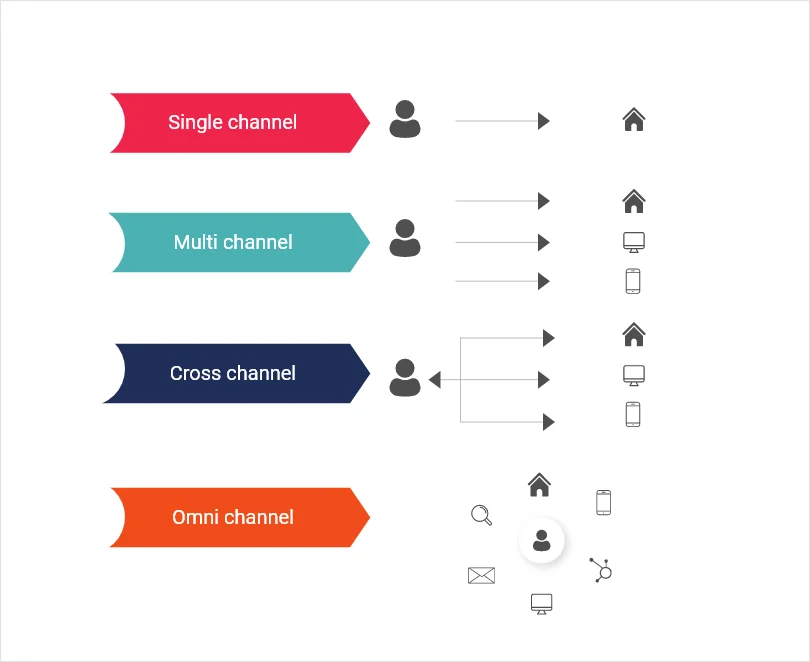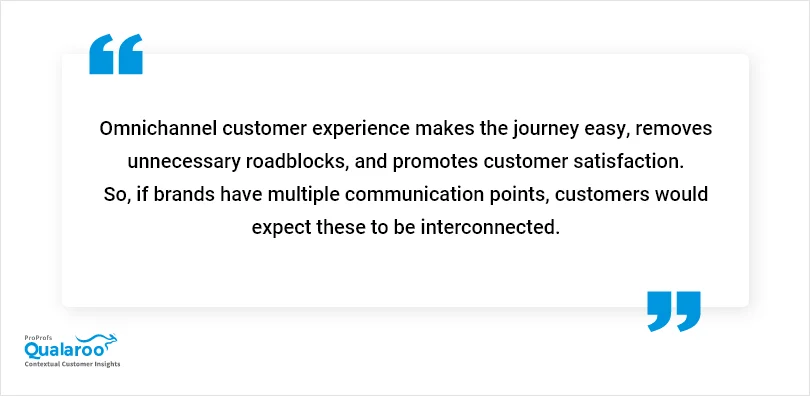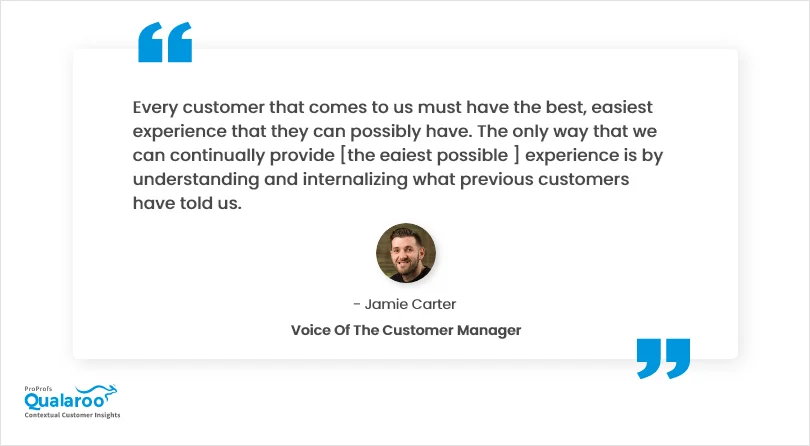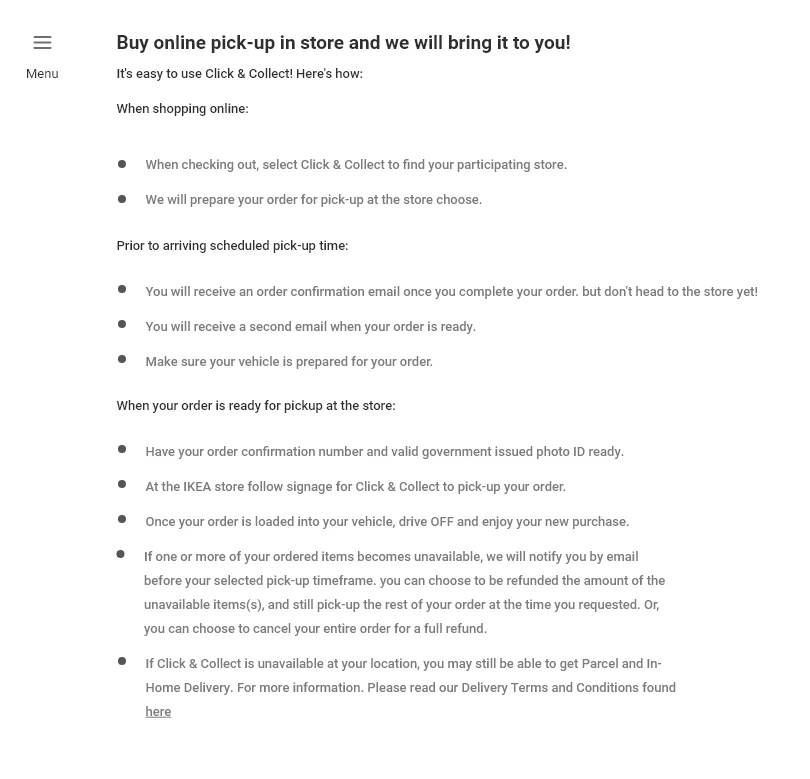Omnichannel customer experience means seamless unified interactions across various channels.
With the ever-growing customer touchpoints, the difference between offline and online interactions is getting smaller.
More channels mean more accessible options, but it also presents a new challenge – the need to connect them. That’s what is called an omnichannel experience.
With such an interconnected array of channels, customers can switch from one channel to another if they face issues along their journey to move toward the end of the conversion funnel.
But before getting started on an omnichannel experience, you need to map the channels they use.
That’s why we have compiled this blog for you. We’ll break down the basics of the omnichannel customer experience, show how you can map the most important customer touchpoints, and put down steps to build a seamless experience throughout. We have also added real-life examples of brands doing it successfully.
Let’s go.
What Is Omnichannel Customer Experience: Defined
Omnichannel customer experience is defined as the ability of the customer to interact with a brand seamlessly across different channels/mediums without breaking the engagement.
It means each channel is connected to another, and the customer can start the interaction from one channel and continue it on the other without the need to start over.
Suppose a customer is talking to an agent on live chat. In an omnichannel customer journey, the agent can call the customer if the need arises to resolve the issue while creating a helpdesk ticket from the chat window and add the transcript automatically.
In this way, even after their call ends, the next agent can pick up the chat and ticket to get a hold of the situation and provide the resolution without needing the customer to repeat themselves.
Read More: Best Customer Management Tools for 2025
Omnichannel vs. Multichannel Customer Experience
Simply put, the difference between the omnichannel and multichannel experience is seamless interactions.

A multichannel customer experience is when a customer uses different channels to connect with a brand or business. These channels may or may not be connected.
Now if these channels are interconnected to create one seamless journey from one point to another in the conversion funnel, it becomes an omnichannel customer experience.
| Multichannel Experience + Seamless Interconnectivity = Omnichannel Experience |
Do Customers Expect Omnichannel?
Well, that’s a grave understatement in a market where 80% of the top companies are building up to compete solely on the customer experience.
Let’s take a simple example of Google Docs and Microsoft Word.
Before Microsoft 365, you could only save the Word document on local device storage and share it via email. The recipient could open the doc and make the changes. Then they had to send it back to you. And this back and forth continued.
But Google Docs solved all these problems by creating a seamless omnichannel experience:
- You can share the doc with others using a simple link.
- Access the Google Doc page from any device.
- Collaborate with other team members on the same doc in real-time.
Another example is your average e-commerce website and its mobile app.
You can add a bunch of stuff to the cart from the website. Then you can log into the app on the go and continue shopping without the need to rebuild the list.

Importance of Omnichannel Customer Experience
Omni-channel customer experience directly ties down to your business KPIs, like how customers perceive your brand, retention rate, and satisfaction.
1. Seamless Integration Across Channels
Interconnecting various touchpoints lets you deliver a consistent experience across online, in-store, and social media platforms, leading to better customer satisfaction and increased brand loyalty.
2. Personalized Customer Experiences
Different customer segments have their own preferences and modes of communication. Understanding how they interact with your brand can help you build tailored experiences for these segments. You can set up personalized notifications, product offerings, and marketing campaigns along their journeys to improve engagement and increase conversions.
Read More: Best Customer Management Tools for 2025
3. Enhanced Accessibility and Improved Support
An omnichannel approach to customer support can help businesses provide timely assistance and first-time resolution. Mapping the most used touchpoints lets you install appropriate service channels to enhance the overall experience. And since these are all interconnected, you can divert the customer to a different medium if needed for better accessibility.
4. Leveraging Data and Analytics for Improvement
Promoting omnichannel experiences also opens doors for continuous optimization. You can gather data from various channels using surveys and feedback. Identifying the areas of improvement and optimizing the processes needing attention can enhance the user experience.
5 Benefits of Omnichannel Customer Experience
1. Improved Customer Satisfaction
When customers can seamlessly navigate between touchpoints across their journey without facing difficulties or losing communication, they are more likely to be happy with the products and services. And even if they encounter an issue, they can quickly connect with your teams via any medium to get it resolved. Overall this helps to improve customer satisfaction and delight.
Read More: Best Customer Management Tools for 2025
2. Increased Customer Loyalty
A well-crafted omnichannel customer experience strategy can boost customer retention and repurchase probability. Whether it’s checkout or service-related interactions, users are more likely to come back to you if they can complete their goals without losing progress or getting frustrated.
Plus, you can retarget these customers on their preferred channels via omnichannel marketing to encourage them to return for more purchases and boost long-term relationships.
3. Higher Conversion Rates
An omnichannel experience does not mean issues won’t pop up along the conversion funnel. It allows customers to use other mediums and progress toward conversion without getting stuck if they need help. This seamless approach can create a sense of effortless interactions and can lead to lower shopping abandonment, which automatically translates to higher conversion rates.
And mapping the channels lets you create personalized marketing campaigns for improved customer engagement and conversions.
4. Streamlined Customer Support
Integrating customer service channels reduces data mismanagement and delays in service. With a centralized customer data hub like a cloud contact center, businesses can promptly respond to customer inquiries and switch between mediums if needed. It also allows for better reachability to communicate with customers on their preferred channels.
5. Higher Returns on Marketing Efforts
Omnichannel marketing tends to produce higher ROI as compared to single-channel experiences.
There’s a reason for this behavior. Targeting prospects on multiple channels and allowing them to move from one medium to another without friction makes them more likely to complete their purchase.
Suppose a user sees your ad on its Instagram feed. They click on the ad and are taken directly to their mobile browser’s web app product page. They can now add the product to the cart and place the order without any hassle. It’s better than a separate page link that prompts them to download the app and place the order.
7 Practical Tips for Building an Omnichannel Customer Experience
1. Map Customer Journeys
The quest for true omnichannel CX starts with finding out what channels customers use to contact you.
If you want to interconnect all the interaction points, you must know where they are. That’s what customer journey mapping is for.
It helps to break the overall customer experience into small individual interactions and visualize which channels customers use at different stages of their journey, i.e., from consideration to conversion and support.
The best thing about the customer journey map is it shows how customers feel at each of these touchpoints so you can quickly track the ones which the lowest CX scores and prioritize them.
Remove the roadblocks to interconnect each and create a seamless omnichannel experience from start to end.
2. Create a Customer Feedback Loop
Creating a customer feedback loop achieves two things:
- Provides insights into the bottlenecks and issues with your current customer channels and mediums.
- Helps you discover previously unknown channels that customers want from you.
Suppose a business wants the customer to complete their KYC (Know your customer) procedure. The process requires the customer to visit the bank and submit their documents personally.
Luckily the bank has a survey form that asks the customers about their experience to collect customer feedback.
While sorting the data, the team finds that people are unhappy, and many have suggested implementing a system that can facilitate them to complete KYC online. So, the bank introduces a video call feature to complete the process online.
Imagine how satisfied these and future customers would be.
The same goes for optimizing the current channels. Using targeted surveys, you can collect valuable insights to see which channels require work to establish an omnichannel customer experience.
Here’s how to use insights to deliver an omnichannel user experience:
- Dig through the data to pinpoint customers’ issues and problems at these interaction points.
- Implement measures to resolve these issues.
- Rerun the surveys and monitor the CX index over time to track changes in the CX scores.
- If they improve consistently, it means your strategies are working. If not, tweak them further.
- You can also ask for suggestions to identify new mediums for connecting with your customers.
Read More: Top Customer Satisfaction Metrics to Track
The biggest challenge while working with customer feedback is sorting through the raw data for insights. If you have large data sets, the process becomes tedious and lengthy.
Fortunately, advanced survey tools like Qualaroo offer AI-based analysis techniques like sentiment analysis to categorize the data in real time.
You can sort the data quickly and track customer sentiments along various channels to close the feedback loop.
3. Leverage Customer Data
One of the biggest reasons for the lack of an omnichannel approach is the absence of a comprehensive customer analytics platform across channels.
Just like feedback, customer data also point you toward the most-used channels by the customers and how they feel about their experience with a particular medium.
Suppose you want to focus on high-value prospects and customers. These customers tend to bring higher average revenue, so delivering them a seamless omnichannel experience makes sense.
Creating a journey map for high-value customer segments may take some time. But if you can use a robust CRM like BIGContacts to dig into the first-hand customer data and get started with your omnichannel customer experience strategy.
Here’s a cool strategy to optimize the experience for your high-value prospects and customers:
- Log into your CRM and filter the data based on spending or proposed purchase value.
- Review the client history and list the most used channels and their effectiveness.
| Tip: To map the customer experience at each channel, always pair it with a CSAT survey. This way, you can track the customer satisfaction level with time. |
- Pick the ones with a high usage volume but lower CSAT scores. Optimizing these will help you plug in the drop-off points for high-value prospects.
- Now, monitor the scores for these channels over time to see if your strategies are working.
4. Divert Customers to the Most Optimized Channels
Effective service communication channels between a brand and customers can range from 3 to 6 or more, depending on how many different touchpoints you offer.
If we take your social media handles into account, the number goes over 10. You may want to provide an exceptional omnichannel customer experience in all these mediums, but realistically, it’s not possible to keep the same level of engagement and satisfaction.
So, the best practice is to find and prioritize the most popular channels for optimization. Then create workflows to divert the prospect and customers from other channels to these main ones.
For example, suppose you have a SaaS-based start-up with limited call resources. In that case, you can facilitate live chat as the main communication medium and escalate only high-priority cases to call. People can handle multiple chats at once as opposed to calls. With chatbots, you can further reduce the load on your staff.
It would alleviate pressure on your service teams and lower the call waiting (one of the main reasons for customer dissatisfaction).
In the same way, if someone leaves feedback for your brand on social media, reply to their comment or post and ask them to contact your staff over the most reliable medium for a quick response, like call, email, or chat.
5. Build Omnichannel CX Around Support Mediums
Support channels are a prominent driver for a delightful customer experience. We are not saying this. Industry leaders say this!
So weaving your support channels into your omni-channel experience strategy is necessary for any business.
It means enabling customers to connect with you from any medium and move from one channel to another without breaking the interactions.
Here are some ways to promote omnichannel customer experience on your support services:
- Map customers’ preferred service channels and optimize them.
- Integrate your live chat with the helpdesk system to let agents raise tickets during the live chat.
- Employ an AI-based chatbot to help customers at odd hours and set workflows so it can schedule call back and appointments into your CRM. Then the teams can pick it up and proactively follow up with the client.
In the same way, you can connect your feedback tools with your workspace software.
Suppose you use a feedback tool like Qualaroo.
You can integrate with Slack to parse the feedback data into Slack channels and work on them quickly.
6. Don’t Forget About Offline Stores
While digital mediums dominate the customer product discovery stage, physical stores still play an important role in the purchase phase.
In fact, 83% of people still find retail their top channel when making purchases
So, taking the offline channels with the online ones is imperative to design a truly consistent omnichannel customer experience. Simple strategies using the internet and smart targeting can help you bridge the gap between the two.
Here’s how:
- Using geo-targeting to send personalized notifications and ads based on customers’ location. When a prospect is near your store, you can send them vouchers or deals to encourage them to shop.
- E-bill is also a simple concept to move the in-store queues faster and streamline customer experience as it eliminates the need to store paper bills. You can send the bills directly to the customer’s account. It also helps to capture the contact information of new customers for marketing purposes.
- Sending smart notifications to customers who visit the offline store to update them about the products they recently browsed on the website.
- Using smart notifications to the customers about the recently browsed brand products when they visit the offline shop.
Here’s a case in point for an integrated omnichannel experience- Amazon GoStore
There’s no better example of a seamless merger between retail and online experience than Amazon’s GoStores.
In 2019, the brand launched its Amazon GoStore concept to curb checkout queues and paper bills to provide a unique experience to shoppers.
As they enter the Amazon GoStore, the customers just scan their mobile app at the entrance and start adding the items to their baskets. The products are automatically added to the shopping cart in the app, and they can pay for the order online without the need to wait at the checkout counter.
7. Use a Centralized Communication Platform
If you are engaging customers on multiple platforms, collating the data from all the mediums into one place to streamline experience management makes sense.
Say you have social handles on Instagram, Twitter, Facebook, and Linkedin. You can use a social media platform like Hootsuite to channel all the brand-related comments, posts, brand mentions, interactions, and user activity into a single dashboard to streamline management.
It would help identify complaints, promptly reply to comments and engage with your customer base without adding extra resources and staff.
In the same way, you can use a multi-channel feedback tool like Qualaroo to collect data from multiple sources in one place.
For example, you can deploy surveys on your website, app, mobile browser, social media, email, etc., to collect target feedback.
It would help analyze and visualize the fragmented data, identify the gaps across the multiple channels, and optimize the omnichannel experience.
FREE. All Features. FOREVER!
Try our Forever FREE account with all premium features!
5 Real Brand Examples That Offer Omnichannel Customer Experience
1. Belron (Seamless Experiences From Online to in-Store)
Belron – a UK-based windshield manufacturer, targets drop-off points along the customer journey to design a flawless omnichannel experience for customers.
The team aims to provide the easiest experience to every customer that reaches its offline store. The company uses website exit-intent surveys to collect feedback from people who leave the website without purchasing.

The open-ended responses are then analyzed through AI-based sentiment analysis to close the feedback quickly.
The insights are used to design strategies for optimizing the crucial moments along the journey and impart a positive perception in customers’ minds.
The result: Belron maintains a stellar NPS score of 80.
2. Standard Chartered
Banks worldwide strive to merge offline and online interactions into one streamlined customer experience, and Standard Chartered is no different.
You can complete all the banking services, like transfers, investing, bill payments, etc., from the bank’s website or mobile app. It also lets you open an account easily with online KYC, raise a complaint, and submit a request for new cards.
These features cut down the hassle for customers as they don’t need to visit the branch for day-to-day services resulting in a true omnichannel customer experience.
3. IKEA
IKEA is constantly innovating to expand its services to new channels and deliver exceptional experiences for both online and offline customers.

With features like ‘Click and Collect,’ customers can place orders online and collect the product from the nearest stores of their choice. They can track the order through the app and receive regular notifications about its status.
Effortless experiences combined with transparent policies have helped IKEA to become one of the biggest brands in the world.
4. Taco Bell
When the pandemic hit, Taco Bell came up with the concept of ‘Taco Bell Go Mobile’, where customers can place an order from their mobile app and pick it up from Taco Bell when it’s ready.
To make the omnichannel experience seamless, the brand added a second drive-thru for mobile order pickups to its stores.
Using smart synchronization technology, the store updates the customers about their order status and points them to the most efficient way to quickly get the food.
The plan is working for Taco Bell even after the pandemic, with the demand for drive-thru pick-ups soaring by the day.
5. Burberry
Burberry’s omnichannel strategy aims to connect with people where they are. The brand partnered with Instagram to introduce Insta checkout. It’s also one of the first brands in the world to enable shopping on WeChat.
But the most brilliant strategy of the brand was leveraging social media to sell its product line. The company created a new product line, Series B, available only in a 24-hour window on the 17th of each month. These products can only be bought on Instagram and other social channels.
The limited availability and hype made SeriesB one of the most popular products on social media.
Meet the Customers Where They Are
Embracing an omnichannel customer experience is about creating seamless and personalized customer interactions across multiple touchpoints. When done right, it can increase customer satisfaction, loyalty, and, ultimately, business growth.
Implementing such a system may take time and resources, but the benefits outweigh the efforts.
So start by identifying your most popular mediums and how customers use them. Then, collect customer feedback to gauge their experience at these touchpoints.
From there, you can start integrating them to streamline the in-the-moment and overall experiences. Collect regular insights to identify unknown channels and find ways to integrate them with your existing mediums.
So use the above strategies to build experiences that encourage customers to return for more.
Frequently Asked Questions
What are the three best tools for improving the omnichannel customer experience?
There are multiple tools that can be used to impart an omnichannel experience, like
- Feedback tools like Qualaroo
- Support tools like Live chat
- Service-based tools like ProProfe HelpDesk
 Tips
Tips
We’d love to hear your tips & suggestions on this article!
FREE. All Features. FOREVER!
Try our Forever FREE account with all premium features!

 We'd love your feedback!
We'd love your feedback! Thanks for your feedback!
Thanks for your feedback!

